Related Research Articles

Laser science or laser physics is a branch of optics that describes the theory and practice of lasers.
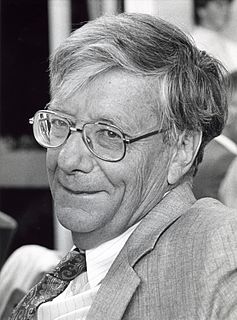
Nicolaas Bloembergen was a Dutch-American physicist and Nobel laureate, recognized for his work in developing driving principles behind nonlinear optics for laser spectroscopy. During his career, he was a professor at Harvard University and later at the University of Arizona and at Leiden University in 1973.
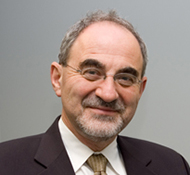
Eli Yablonovitch is an American physicist and engineer who, along with Sajeev John founded the field of photonic crystals in 1987. He and his team were the first to create a 3-dimensional structure that exhibited a full photonic bandgap, which has been named Yablonovite. In addition to pioneering photonic crystals, he was the first to recognize that a strained quantum-well laser has a significantly reduced threshold current compared to its unstrained counterpart. This is now employed in the majority of semiconductor lasers fabricated throughout the world. His seminal paper reporting inhibited spontaneous emission in photonic crystals is among the most highly cited papers in physics and engineering.
Quantum optics is a branch of atomic, molecular, and optical physics dealing with how individual quanta of light, known as photons, interact with atoms and molecules. It includes the study of the particle-like properties of photons. Photons have been used to test many of the counter-intuitive predictions of quantum mechanics, such as entanglement and teleportation, and are a useful resource for quantum information processing.
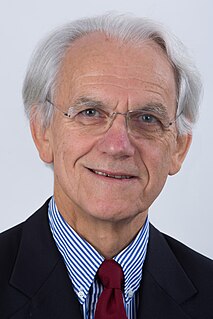
Gérard Albert Mourou is a French scientist and pioneer in the field of electrical engineering and lasers. He was awarded a Nobel Prize in Physics in 2018, along with Donna Strickland, for the invention of chirped pulse amplification, a technique later used to create ultrashort-pulse, very high-intensity (petawatt) laser pulses.
Federico Capasso, a prominent applied physicist, was one of the inventors of the quantum cascade laser during his work at Bell Laboratories. He is currently on the faculty of Harvard University. He has co-authored over 450 papers, edited four volumes, and holds over 60 US patents.

Ataç İmamoğlu is a Turkish-Swiss physicist working on quantum optics and quantum computation. His academic interests are quantum optics, semiconductor physics, and nonlinear optics.
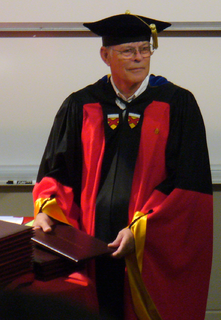
Robert Louis Byer is a physicist. He was president of the Optical Society of America in 1994 and of the American Physical Society in 2012.
Erich P. Ippen is a principal investigator in the Research Laboratory of Electronics (RLE) at the Massachusetts Institute of Technology (MIT). He holds appointments as the Elihu Thomson Professor of Electrical Engineering Emeritus and Professor of Physics Emeritus. He is one of the leaders of RLE’s Optics and Quantum Electronics Group.
Paul Bruce Corkum is a Canadian physicist specializing in attosecond physics and laser science. He holds a joint University of Ottawa–NRC chair in Attosecond Photonics. He is one of the students of strong field atomic physics, i.e. atoms and plasmas in super-intense laser fields.

Amnon Yariv is an Israeli-American professor of applied physics and electrical engineering at Caltech, known for innovations in optoelectronics. Yariv obtained his B.S., M.S. and PhD. in electrical engineering from University of California, Berkeley in 1954, 1956 and 1958, respectively.

Robert William Boyd is an American physicist noted for his work in optical physics and especially in nonlinear optics. He is currently the Canada Excellence Research Chair Laureate in Quantum Nonlinear Optics based at the University of Ottawa, Professor of Physics cross-appointed to the School of Electrical Engineering and Computer Science at the University of Ottawa, and Professor of Optics and Professor of Physics at the University of Rochester.
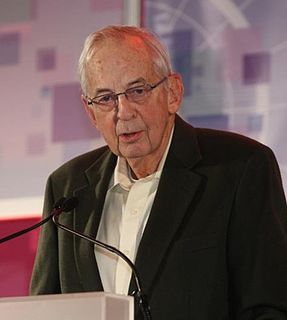
James Power Gordon was an American physicist known for his work in the fields of optics and quantum electronics. His contributions include the design, analysis and construction of the first maser in 1954 as a doctoral student at Columbia University under the supervision of C. H. Townes, development of the quantal equivalent of Shannon's information capacity formula in 1962, development of the theory for the diffusion of atoms in an optical trap in 1980, and the discovery of what is now known as the Gordon-Haus effect in soliton transmission, together with H. A. Haus in 1986. Gordon was a member of the National Academy of Engineering and the National Academy of Sciences.

Duncan G. Steel is an American experimental physicist, researcher and professor in quantum optics in condensed matter physics. He is the Robert J. Hiller Professor of Electrical Engineering, Professor of Physics, Professor of Biophysics, and Research Professor in the Institute of Gerontology at the University of Michigan. Steel is also a Guggenheim Scholar and a Fellow of American Physical Society, the Optical Society of America, and the Institute of Electrical and Electronics Engineers. He coedited the five-volume series on the Encyclopedia of Modern Optics.

Luigi Lugiato is an Italian physicist and professor emeritus at University of Insubria (Varese/Como). He is best known for his work in theoretical nonlinear and quantum optics, and especially for the Lugiato–Lefever equation (LLE,). He has authored more than 340 scientific articles, and the textbook Nonlinear Dynamical Systems. His work has been theoretical but has stimulated a large number of important experiments in the world. It is also characterized by the fact of combining the classical and quantum aspects of optical systems.

David A. B. Miller is the W. M. Keck Foundation Professor of Electrical Engineering at Stanford University, where he is also a Professor of Applied Physics by courtesy. His research interests include the use of optics in switching, interconnection, communications, computing, and sensing systems, physics and applications of quantum well optics and optoelectronics, and fundamental features and limits for optics and nanophotonics in communications and information processing.
Kenju Otsuka is a Japanese engineer and physicist concerned with lasers and quantum electronics.
Martin D. Dawson FInstP FOSA FIEEE FRSE FRS is a British professor of photonics who is research director of the Institute of Photonics at the University of Strathclyde and is Head of Fraunhofer Centre for Applied Photonics. He has made pioneering contributions in several applied photonics areas.
Herbert Graves Winful is a Ghanaian-American engineering professor, whose numerous honours include in 2020 the Quantum Electronics Award. He is the Joseph E. and Anne P. Rowe Professor of Electrical Engineering, Arthur F. Thurnau Professor of Electrical Engineering and Computer Science, and a Professor of Physics at the University of Michigan.
Alexander Luis Gaeta is an American physicist and the David M. Rickey Professor of Applied Physics at Columbia University. He is known for his work on quantum and nonlinear photonics. He is a Fellow of the American Physical Society, Optica, and of the Institute of Electrical and Electronics Engineers.
References
- ↑ Date information sourced from Library of Congress Authorities data, via corresponding WorldCat Identities linked authority file (LAF) .
- ↑ Ferguson, A. I. (1 August 2001). "Honorary Editor's introduction". Journal of Physics D: Applied Physics. IOP Publishing. 34 (16): 34. doi:10.1088/0022-3727/34/16/001. ISSN 0022-3727.
- ↑ "David Hanna". Archived from the original on 21 December 2010. Retrieved 9 October 2018.
- ↑ "Born medal recipients". Institute of Physics. Archived from the original on 16 March 2020. Retrieved 9 October 2018.
- ↑ "QEOD Prizes - EPS Quantum Electronics Prizes". European Physical Society (EPS). 1 August 2018. Retrieved 9 October 2018.
- ↑ "Charles Hard Townes Medal". The Optical Society. Retrieved 7 October 2018.
- ↑ "David Hanna". Royal Society. 2015. Retrieved 9 October 2018.